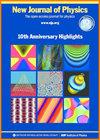Ultrafast artificial intelligence: machine learning with atomic-scale quantum systems
IF 2.8
2区 物理与天体物理
Q2 PHYSICS, MULTIDISCIPLINARY
引用次数: 0
Abstract
We train a model atom to recognize pixel-drawn digits based on hand-written numbers in the range 0–9, employing intense light–matter interaction as a computational resource. For training, the images of the digits are converted into shaped laser pulses (data input pulses). Simultaneously with an input pulse, another shaped pulse (program pulse), polarized in the orthogonal direction, is applied to the atom and the system evolves quantum mechanically according to the time-dependent Schrödinger equation. The purpose of the optimal program pulse is to direct the system into specific atomic final states (classification states) that correspond to the input digits. A success rate of about 40% is achieved when using a basic optimization scheme that might be limited by the computational resources for finding the optimal program pulse in a high-dimensional search space. Our key result is the demonstration that the laser-programmed atom is able to generalize, i.e. successful classification is not limited to the training examples, but also the classification of previously unseen images is improved by training. This atom-sized machine-learning image-recognition scheme operates on time scales down to tens of femtoseconds, is scalable towards larger (e.g. molecular) systems, and is readily reprogrammable towards other learning/classification tasks. An experimental implementation of the scheme using ultrafast polarization pulse shaping and differential photoelectron detection is within reach.超快人工智能:利用原子尺度量子系统进行机器学习
我们利用强烈的光-物质相互作用作为计算资源,训练一个原子模型来识别基于像素绘制的 0-9 范围内的手写数字。在训练过程中,数字图像被转换成形状各异的激光脉冲(数据输入脉冲)。在输入脉冲的同时,另一个沿正交方向偏振的整形脉冲(程序脉冲)被施加到原子上,系统根据随时间变化的薛定谔方程进行量子力学演化。最佳程序脉冲的目的是引导系统进入与输入数字相对应的特定原子最终状态(分类状态)。使用基本优化方案时,成功率约为 40%,而在高维搜索空间中寻找最佳程序脉冲可能会受到计算资源的限制。我们的关键成果是证明了激光编程原子能够泛化,即成功的分类不仅局限于训练实例,还能通过训练改进以前未见过的图像的分类。这种原子大小的机器学习图像识别方案可在低至几十飞秒的时间尺度内运行,可扩展到更大(如分子)的系统,并可随时重新编程,用于其他学习/分类任务。利用超快偏振脉冲整形和差分光电子探测技术,该方案的实验实施指日可待。
本文章由计算机程序翻译,如有差异,请以英文原文为准。
求助全文
约1分钟内获得全文
求助全文
来源期刊

New Journal of Physics
物理-物理:综合
CiteScore
6.20
自引率
3.00%
发文量
504
审稿时长
3.1 months
期刊介绍:
New Journal of Physics publishes across the whole of physics, encompassing pure, applied, theoretical and experimental research, as well as interdisciplinary topics where physics forms the central theme. All content is permanently free to read and the journal is funded by an article publication charge.
 求助内容:
求助内容: 应助结果提醒方式:
应助结果提醒方式:


